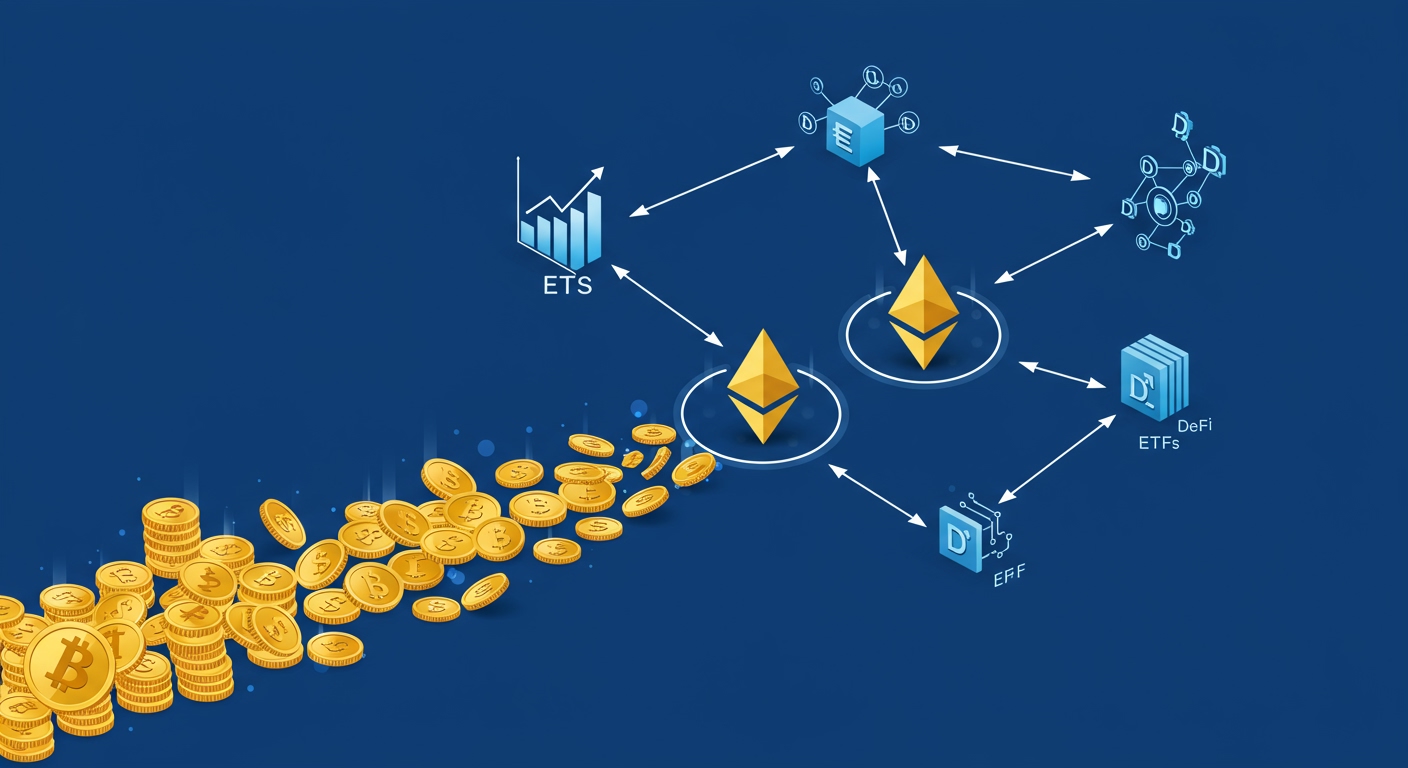The Unthinkable Flip: What Happens When Ethereum Surpasses Bitcoin in Price?
For years, Bitcoin has reigned supreme as the undisputed king of cryptocurrency, its price and market capitalization setting the benchmark for the entire digital asset ecosystem. Yet, the question of whether another asset, particularly Ethereum, could one day challenge that dominance is a persistent whisper in the crypto community. While ‘the flippening’ often refers to market cap, imagining a world where Ethereum Surpasses Bitcoin in Price per coin is an even more profound thought experiment. This isn’t just a speculative forecast; it’s a critical ‘what if’ scenario that could redefine the very foundations of the crypto world, ushering in an era of unprecedented technological, economic, and social shifts. Let’s delve into the intricate layers of such a historic event and its far-reaching implications.
Key Takeaways:
- A price flip where Ethereum surpasses Bitcoin in price would trigger immediate market shockwaves, leading to significant capital reallocation and investor psychological shifts.
- Ethereum’s enhanced utility and smart contract capabilities would likely accelerate development on its network and Layer-2 solutions, potentially impacting the entire altcoin ecosystem.
- Regulatory bodies would face intensified pressure to classify and govern dominant smart contract platforms, leading to potential geopolitical shifts in digital finance.
- Institutional investment strategies would evolve beyond simple allocation, exploring new financial products and market structures centered around Ethereum.
- Ethereum’s Proof-of-Stake model would amplify environmental, social, and governance (ESG) narratives, placing renewed pressure on Proof-of-Work chains like Bitcoin.
- The shift could bring new challenges for Ethereum, including increased regulatory scrutiny, network congestion at higher scales, and the weight of becoming the industry’s primary target.
The Unfolding of a Historic Price Flip: A Step-by-Step Scenario
While often discussed, a scenario where Ethereum’s individual price token overtakes Bitcoin’s would be a landmark event, far more impactful than just a market cap flippening. Imagine the initial triggers: perhaps a sustained period of unprecedented utility growth for Ethereum, driven by a surge in decentralized applications (dApps), non-fungible tokens (NFTs), and scaling solutions, coupled with a period of stagnation or perceived lack of innovation for Bitcoin. Macroeconomic factors, such as a flight to more ‘productive’ assets during a global economic shift, could also play a role.
The moment of the flip itself would be characterized by extreme volatility. High-frequency trading algorithms, designed to react to market sentiment and technical indicators, would amplify price movements. Retail investors, fueled by FOMO (Fear Of Missing Out) and the ‘new king’ narrative, would likely pour capital into Ethereum, while some Bitcoin holders might capitulate, further exacerbating the swing. This would create immediate, dramatic market shockwaves, potentially leading to circuit breakers on exchanges and a flurry of panic buying and selling across the entire crypto spectrum. Capital, once firmly anchored in Bitcoin as the primary store of value, would aggressively reallocate, searching for the new perceived safe haven and growth engine.

Psychological Ripple Effects: From Maximalist Wars to Mainstream Adoption
The psychological impact of Ethereum Surpasses Bitcoin in Price would be profound, fundamentally altering the crypto community’s identity and perception. For ardent Bitcoin maximalists, it would be a moment of disbelief and potentially, a forced re-evaluation of their core tenets. The narrative of Bitcoin as the sole digital gold, unassailable in its position, would be severely tested, leading to intense debates and, for some, a painful capitulation.
Conversely, Ethereum maximalists and proponents of smart contract platforms would experience a triumphant vindication. Their long-held belief in Ethereum’s utility and technological superiority would be validated, likely fueling renewed fervor and attracting a new wave of developers and users to the ecosystem. For the broader public and traditional financial institutions, this event would signal a maturation of the crypto market, where utility and innovation are rewarded, rather than just first-mover advantage. This ‘new king’ narrative could spark increased mainstream interest, drawing in fresh capital and further accelerating adoption globally, leading to a shift in how digital assets are perceived in everyday life.
Reshaping the Technological Landscape: Innovation and Interoperability Post-Flip
With Ethereum’s price dominance, its role as the magnet for blockchain developers would intensify dramatically. This would lead to an explosion of innovation, with more resources, talent, and capital pouring into building on the Ethereum network. Solutions for scalability, security, and user experience would accelerate, making the platform even more robust and accessible.
The impact on Layer-2 solutions would be particularly significant. As demand for Ethereum’s blockspace surges, Layer-2s like Arbitrum, Optimism, zkSync, and Polygon would become even more critical for managing transaction volume and keeping fees low. Their adoption would likely skyrocket, turning them into indispensable components of the broader Ethereum ecosystem. For the altcoin market, a price flip could have dual effects. Some altcoins deeply integrated into the Ethereum ecosystem might see a correlated rally, benefiting from the halo effect. Others, especially those competing directly with Ethereum’s smart contract capabilities, might face increased pressure to differentiate or risk being overshadowed. The entire blockchain industry would be forced to adapt, with other chains either specializing in niche applications or accelerating their own technological roadmaps to compete with a newly dominant Ethereum.
Economic Paradigm Shift: Investment Strategies and Financial Products
The implications for institutional investment would extend far beyond simply shifting asset allocations from Bitcoin to Ethereum. Financial institutions would likely begin to explore entirely new financial products and market structures. We could see the rapid development of Ethereum-based ETFs, futures, options, and structured products designed to offer exposure to its growth and utility. Asset managers might create new indices that give greater weight to programmable blockchains, fundamentally altering portfolio construction in the digital asset space.
Retail investment trends would also evolve, with Ethereum becoming the new ‘blue chip’ crypto, attracting more conservative investors seeking long-term growth and yield. The Decentralized Finance (DeFi) sector, predominantly built on Ethereum, would likely see an unprecedented boom. New protocols, lending platforms, and decentralized exchanges would emerge, further solidifying Ethereum’s role as the foundational layer of the future financial system. Investors would increasingly focus on yield opportunities, staking rewards, and participation in the burgeoning dApp economy.

Regulatory Scrutiny and Geopolitical Implications
A scenario where Ethereum Surpasses Bitcoin in Price would inevitably lead to intensified regulatory scrutiny. Regulators globally would be forced to more definitively classify Ethereum: is it a ‘security’ given its initial coin offering and ongoing development, or a ‘commodity’ like Bitcoin, or perhaps a new hybrid category? This debate would have significant implications for how it’s taxed, traded, and integrated into traditional finance. Governments might also see Ethereum’s dominance as a geopolitical factor, potentially leading to national strategies around blockchain technology and digital currencies, aiming to either embrace or control its influence.
The environmental narrative, particularly Ethereum’s successful transition to Proof-of-Stake (PoS), would become a central point of discussion. Regulators and policymakers, often concerned with the energy consumption of Proof-of-Work (PoW) blockchains, would likely laud Ethereum’s greener footprint. This could place renewed pressure on Bitcoin and other PoW chains to address their energy consumption, potentially influencing future regulatory frameworks and public perception.
Here’s an example of the kind of regulatory discussions already taking place around crypto (requires subscription).
Why the Flip? Projecting Future Convergence and Divergence
The ‘why’ behind such a flip extends beyond current utility to future technological convergence and divergence. Bitcoin’s core value proposition remains its role as a decentralized, scarce, and censorship-resistant store of value. Ethereum, however, offers a platform for programmable money, smart contracts, and a vast ecosystem of decentralized applications. A price flip would suggest that the market increasingly values this utility, recognizing Ethereum not just as a currency but as the foundational infrastructure for a new digital economy.
This shift would highlight a divergence in market perception: while Bitcoin is akin to digital gold, Ethereum is evolving into digital oil, powering countless applications and services. The convergence of various technologies — artificial intelligence, Web3, tokenized real-world assets — all finding a home on Ethereum’s robust smart contract platform, could be the ultimate catalyst. The network effects, driven by its massive developer community and active use cases, would accelerate, creating a powerful feedback loop that further cements its position.
The PoS Advantage: Energy, Environment, and Public Perception
Ethereum’s transition to a Proof-of-Stake (PoS) consensus mechanism has dramatically reduced its energy consumption, making it significantly more environmentally friendly than Bitcoin’s Proof-of-Work (PoW). If Ethereum Surpasses Bitcoin in Price, this environmental narrative would become a powerful differentiator. In a world increasingly focused on ESG (Environmental, Social, and Governance) factors, Ethereum’s ‘green’ credentials would provide a significant advantage for corporate and institutional adoption. Companies seeking to align with sustainable practices would find Ethereum an easier choice, influencing investment decisions and public relations narratives.
This could also fuel a broader public discussion about the environmental impact of blockchain technology. While Bitcoin maximalists would likely defend PoW as a necessary component of security and decentralization, the mainstream appeal of a highly valuable, energy-efficient blockchain like Ethereum could shift public perception and put pressure on other energy-intensive digital assets to follow suit or risk being left behind in the evolving landscape of sustainable finance.
Potential Challenges and Downsides for a Dominant Ethereum
While the prospect of Ethereum’s price dominance is exciting for many, it’s crucial to consider the potential challenges and downsides. As the primary target, Ethereum would face unprecedented levels of regulatory scrutiny, potentially leading to more stringent compliance requirements or even attempts at direct control by state actors. Its decentralization, a core tenet of crypto, could be tested under the weight of such attention.
Furthermore, increased adoption and transaction volume, even with Layer-2 solutions, could lead to new forms of network congestion or security vulnerabilities if not managed effectively. The very success that propels its price could become a bottleneck if scaling solutions struggle to keep pace with demand. The burden of being the industry’s de facto leader would also bring immense pressure to continuously innovate, secure the network, and maintain its open-source, community-driven ethos in the face of immense commercial and political pressures. An internal link to a related article about challenges in crypto regulation could be useful here.
Conclusion: A Glimpse into Crypto’s Evolving Future
The hypothetical scenario where Ethereum Surpasses Bitcoin in Price is more than just a fleeting speculation; it’s a powerful thought experiment that illuminates the potential trajectory of the entire crypto ecosystem. It forces us to consider a future where utility, innovation, and environmental responsibility might play an even greater role in determining market leadership. While Bitcoin’s legacy as the pioneer and digital gold remains undisputed, an Ethereum price flip would herald a new era, characterized by a more functional, interconnected, and perhaps, more regulated digital economy. Such an event would not be the end of the crypto story, but rather a dramatic new chapter, inviting us all to adapt, innovate, and imagine the next frontier.
Frequently Asked Questions (FAQs)
What does it mean if Ethereum ‘flips’ Bitcoin?
Historically, ‘flippening’ referred to Ethereum’s market capitalization surpassing Bitcoin’s. If Ethereum Surpasses Bitcoin in Price, it means the individual unit price of one ETH token would be higher than one BTC token, a more significant and less frequently discussed milestone.
Could Ethereum realistically surpass Bitcoin in price?
While highly challenging due to Bitcoin’s scarcity and established market position, a scenario where Ethereum’s utility dramatically expands, its scalability improves, and institutional adoption surges, coupled with a relative stagnation of Bitcoin, could theoretically lead to a price flip. It’s a complex interplay of technological development, market dynamics, and global economic factors.
How would a price flip impact other cryptocurrencies (altcoins)?
A price flip could lead to a ‘halo effect’ for altcoins within the Ethereum ecosystem, potentially increasing their value. However, it might also intensify competition for other smart contract platforms, forcing them to innovate rapidly or specialize to find their niche in a market dominated by Ethereum.
What are the main arguments for Ethereum’s potential long-term dominance?
Arguments for Ethereum’s long-term dominance often center on its programmable smart contract functionality, vast developer ecosystem, leading position in DeFi and NFTs, and its shift to a more energy-efficient Proof-of-Stake consensus mechanism, which appeals to ESG-conscious investors and institutions.
What challenges would Ethereum face if it became the dominant cryptocurrency by price?
Dominance would likely bring increased regulatory scrutiny, potential network congestion at higher scales, and the immense pressure to maintain its decentralized nature and security against state-level attacks and sophisticated cyber threats. It would become a much larger target for both innovation and criticism.
How does Ethereum’s Proof-of-Stake (PoS) system compare to Bitcoin’s Proof-of-Work (PoW) in this context?
Ethereum’s PoS system consumes significantly less energy than Bitcoin’s PoW, making it more environmentally friendly. If Ethereum Surpasses Bitcoin in Price, its PoS advantage would be heavily emphasized, likely influencing institutional adoption, public perception, and potentially future regulatory frameworks that favor sustainable blockchain technologies.
Would a price flip mean the end of Bitcoin?
Not necessarily. Bitcoin’s role as a decentralized store of value and digital gold would likely persist. A price flip would indicate a shift in market priorities towards utility and programmable money, but Bitcoin could still maintain a significant and crucial role in the broader crypto ecosystem, albeit perhaps not as the absolute price leader.
Tags: ETH price flip, crypto market dominance shift, flippening implications, future of blockchain, post-flippening crypto landscape, Bitcoin vs Ethereum future, altcoin impact, crypto investment strategy, regulatory response crypto




